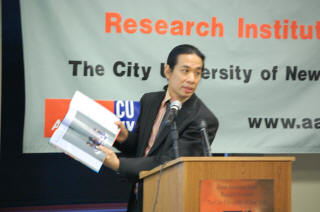
As “Bread is the Staff of Life” to Westerners, rice is essential to the Asian and to the Chinese in particular. It nourishes and underpins the foundation of the culture and the civilization-a symbol of life and living.
In the civil Confucian tradition, meal is a rite at a round table where everyone is at rest sharing the daily bounty. You take only what you need with your own chopsticks and eat off your own bowl. In this deeply relevance ritual, you select your portion and yours dietary likes and dislikes, thus establishing your identity in the community.
There is a sacred bond between the individual with his daily utensils, more than just mannerism as self evidence of how we set our daily table. Chopsticks should always be place on the side. It is taboo to stick chopsticks vertically into the rice bowl because it resembles joss-sticks, an offerings to the dead and not to the living. We honor the departed with offering of incense in the form of joss-sticks.

The September 11th tragedy brought out great massive expression of grieving in all levels of the society, from silence private cry to huge public vigils. Prayer candles were everywhere, and there were mourning at Union Square and at every street corner in all the five boroughs of New York City. A sudden blast of patriotism was observed as the American flag filled every possible surface. I was in the midst of doing my on-going photography series entitled “Eaten Your Fill of Rice?”-a series that focuses on the contemporary correctness of traditional symbolism and allegory on identity and greetings. It so horrified me that I could greet no more. I had to break my own code on silence to speak out on this defiance to humanity. To catharsis this raw pain and anger in the only way that I know how. This is my personal offering to the September 11th and the lost the World Trade Center Twin Towers.
This September 11th installation cries for the nation’s loss of her innocent transforming the seven red strips of the US flag into the seven red bleeding lines-the blood of the victims that wrap around the large bowl. The 10″ diameter width bowl filled with rice not for the living but as sacrificial offering to the dead. Fresh rice filled on the opening day and left to rot and smell through out the duration of the exhibition. The chopsticks marks the Chinese taboo of sticking vertically into the rice bowl, ghostly resembling the lost World Trade Center Twin Towers. Encircling the bowl are 50 stars of the 50 states, on the blue prayer candles shimmering and longing for the departed. There are six stars on each the five tall candles and five stars on each of the four short candles. The low murmuring of Buddhist salvation prayer for the dead is heard in chants emanating from under the low circular table. This is a round low table for one.
When will world nations join in and share at this table of humanity?

Postscript
This Installation was originally intended only to last as a day memorial but Savannah College of Art and Design curated it for their two month long exhibition in their gallery. Flickering light bulbs were used to simulate lit candles, and plastic pallets replacing fresh rice. As the smaller candle bottles were too small, another type of smaller light bulbs had to be used which serendipity created images of fallen stars onto the table top of this already emotionally charged installation. In 2003 two exhibitions in NYC featured this installation – In the Shadow of 9/11: A Chinatown Memorial Exhibition (the red version) and Multiple Memorials – 60+ Proposals (the white version), and it was again exhibited in Des Moines. IA as the third (the blue version) in the series in September 2004.


